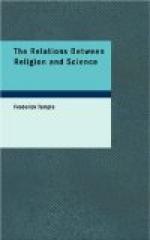And we could not overlook the beauty of Nature and of all created things as part of that purpose coming in many cases out of that very survival of the fittest of which Darwin has spoken, and yet a distinct object in itself. For this beauty there is no need in the economy of nature whatever. The beauty of the starry heavens, which so impressed the mind of Kant that he put it by the side of the Moral Law as proving the existence of a Creator, is not wanted either for the evolution of the world or for the preservation of living creatures. Our enjoyment of it is a super-added gift certainly not necessary for the existence or the continuance of our species. The beauty of flowers, according to the teaching of the doctrine of Evolution, has generally grown out of the need which makes it good for plants to attract insects. The insects carry the pollen from flower to flower, and thus as it were mix the breed; and this produces the stronger plants which outlive the competition of the rest. The plants, therefore, which are most conspicuous gain an advantage by attracting insects most. That successive generations of flowers should thus show brighter and brighter colours is intelligible. But the beauty of flowers is far more than mere conspicuousness of colours even though that be the main ingredient. Why should the wonderful grace, and delicacy, and harmony of tint be added? Is all this mere chance? Is all this superfluity pervading the whole world and perpetually supplying to the highest of living creatures, and that too in a real proportion to his superiority, the most refined and elevating of pleasures, an accident without any purpose at all? If Evolution has produced the world such as we see and all its endless beauty, it has bestowed on our own dwelling-place in lavish abundance and in marvellous perfection that on which men spend their substance without stint, that which they value above all but downright necessities, that which they admire beyond all except the Law of Duty itself. We cannot think that this is not designed, nor that the Artist who produced it was blind to what was coming out of His work.
Once more, the doctrine of Evolution restores to the science of Nature the unity which we should expect in the creation of God. Paley’s argument proved design, but included the possibility of many designers. Not one design, but many separate designs, all no doubt of the same character, but all worked out independently of one another, is the picture that he puts before us. But the doctrine of Evolution binds all existing things on earth into one. Every mineral, every plant, every animal has such properties that it benefits other things beside itself and derives benefit in turn. The insect developes the plant, and the plant the insect; the brute aids in the evolution of the man, and the man in that of the brute. All things are embraced in one great design beginning with the very creation. He who uses the doctrine of Evolution to prove that no intelligence planned the world, is undertaking the self-contradictory task of showing that a great machine has no purpose by tracing in detail the marvellous complexity of its parts, and the still more marvellous precision with which all work together to produce a common result.




